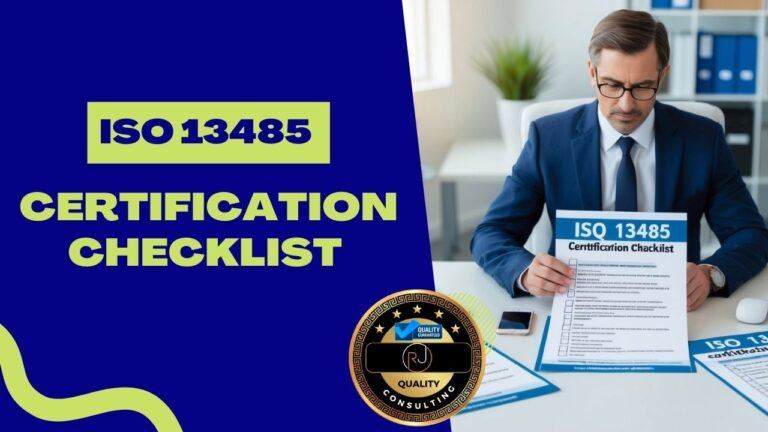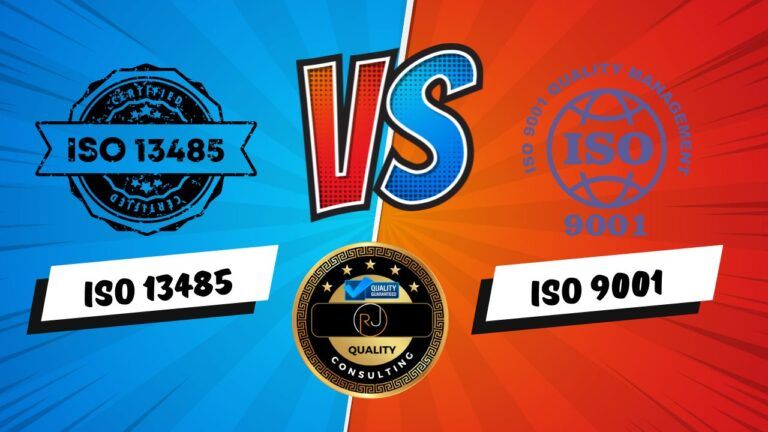ISO 13485 Documentation Requirements: Essential Guide for Medical Device Manufacturers
ISO 13485 sets the standard for quality management systems in the medical device industry. It outlines specific documentation requirements that companies must follow to ensure their products meet regulatory standards. These ISO 13485 documentation requirements are an essential guide for medical device manufacturers to implement and maintain an effective quality management system and to ensure the safety and efficacy of their products.

Companies need to create and maintain various documents to comply with ISO 13485. These include quality manuals, procedures, and records. The goal is to have a clear paper trail that shows how a company manages its processes and ensures product safety and effectiveness.
Meeting ISO 13485 documentation requirements can seem daunting, but it’s crucial for success in the medical device field. Proper documentation helps companies prove they’re following best practices and can speed up regulatory approvals. It also makes it easier to track issues and make improvements over time.
📘 ISO/IEC 17025 Quality Manual Template
Accelerate your lab’s accreditation process with our comprehensive Quality Manual Template, designed to align with ISO/IEC 17025:2017 standards.
- Fully editable and customizable to fit your laboratory’s needs.
- Includes all necessary procedures, forms, and policies.
- Structured to facilitate easy implementation and compliance.
- Developed by experts with extensive ISO/IEC 17025 experience.
Key Takeaways
- ISO 13485 outlines specific documentation needs for medical device quality management
- Proper documentation helps prove compliance and can speed up regulatory approvals
- A well-organized system of records supports continuous improvement in medical device companies
ISO 13485 Overview
ISO 13485 sets the standard for quality management systems in medical device manufacturing. It helps companies meet regulatory requirements and ensure product safety and effectiveness.
Importance in the Medical Device Industry
ISO 13485 is crucial for medical device makers. It helps you create safe, high-quality products that meet rules in different countries. The standard covers all stages of a device’s life, from design to production and service.
By following ISO 13485, you can:
- Improve product quality
- Reduce risks
- Gain customer trust
- Enter new markets easier
Many countries need ISO 13485 for selling medical devices. It shows you can make safe products that work well.
Comparison with ISO 9001
ISO 13485 vs ISO 9001 are both quality management standards, but they have key differences:
- Focus: ISO 13485 is for medical devices, while ISO 9001 is for all industries.
- Risk management: ISO 13485 puts more stress on risk control.
- Rules: ISO 13485 includes specific medical device regulations.
- Customer focus: ISO 9001 aims more at customer satisfaction.
ISO 13485 is based on ISO 9001 but adds extra steps for medical device safety. It helps you meet strict rules in the medical field.
Quality Management System Requirements

ISO 13485 sets out key requirements for medical device quality management systems. These cover several areas that are crucial for ensuring product safety and regulatory compliance.
General QMS Requirements
Your QMS needs to be documented, implemented, and maintained. It should cover all processes that affect product quality. This includes design, manufacturing, and post-market activities.
You must define the scope of your QMS. This includes any outsourced processes. Your quality manual should outline your QMS structure.
Keep records to show your QMS is working as intended. Review and update your system regularly to make sure it stays effective.
ISO 13485 Document Control Procedures
Set up a system to control your QMS documents. This includes procedures, work instructions, and forms.
Make sure documents are:
- Approved before use
- Reviewed and updated as needed
- Available where needed
- Legible and easy to identify
Keep a record of changes and current document versions. Remove outdated documents to prevent confusion.
ISO 13485 Quality Policy and Objectives
Create a quality policy that fits your organization’s goals. Make sure all employees understand and follow it.
Set measurable quality objectives. These should support your quality policy and help improve your QMS.
Review your policy and objectives regularly. Update them as your business and customer needs change.
Management Responsibility
Top management must be committed to the QMS. They need to:
- Set the quality policy and objectives
- Conduct management reviews
- Ensure resources are available
- Communicate the importance of meeting requirements
Appoint a management representative to oversee the QMS. This person reports on its performance and any needs for improvement.
Hold regular management reviews to assess the QMS. Look at audit results, customer feedback, and process performance.
Resource Management
Provide the resources needed for your QMS to work well. This includes:
- Skilled personnel
- Proper infrastructure
- Good work environment
Train your staff on quality requirements. Make sure they understand how their work affects product quality.
Maintain your facilities and equipment. Create a safe and clean work environment that meets product requirements.
Keep records of employee qualifications and training. Update skills as needed to meet changing requirements.
Product Realization

ISO 13485 requires medical device companies to plan and control product realization. This involves managing design, purchasing, production, and measurement processes to ensure safe, effective devices.
Design and Development Processes
You must document your design and development processes. Create a plan that outlines stages, reviews, and responsibilities. Keep records of design inputs, outputs, and changes.
Verify that designs meet requirements through testing and analysis. Validate that devices fulfill their intended use.
Design reviews are crucial. Conduct them at key stages with representatives from relevant functions.
Transfer the design to production carefully. Ensure manufacturing can consistently produce devices meeting specifications.
Purchasing and Supplier Control
You need to evaluate and select suppliers based on their ability to meet your requirements. Create criteria for supplier selection and evaluation.
Document your purchasing process. Specify purchasing information clearly, including product requirements.
Verify purchased products. Establish inspection or other activities to ensure purchased products meet specifications.
Monitor supplier performance. Keep records of evaluation results and actions taken.
Production and Service Provision
Plan and carry out production under controlled conditions. This includes:
- Documenting product characteristics
- Having work instructions available
- Using suitable equipment
- Implementing monitoring activities
- Controlling product release and delivery
For sterile medical devices, validate sterilization processes.
If you offer servicing, document servicing procedures and analyze service records.
Monitoring and Measuring
Control monitoring and measuring equipment used to verify product conformity. This involves:
- Calibrating or verifying equipment at set intervals
- Adjusting equipment as needed
- Identifying equipment to show calibration status
- Protecting equipment from damage
Keep records of calibration results. Assess the validity of previous measurements if equipment is found to be out of calibration.
For software used in monitoring and measurement, confirm its ability to satisfy the intended application before use.
ISO 13485 documentation requirements – Analysis, Assessment and Improvement

ISO 13485 requires you to analyze data, review processes, and make improvements to your quality management system. This helps ensure your medical devices meet safety and performance standards.
Data Analysis and Management Review
You need to collect and analyze data from various sources. This includes production records, customer feedback, and audit results. Look for trends that show where improvements are needed.
Set up a system to track key performance indicators. Review this data regularly with your management team.
During management reviews, discuss quality objectives, audit findings, and customer feedback. Make decisions on how to improve your processes and products.
Keep records of these reviews. Document any actions taken as a result.
Corrective and Preventive Actions
When problems occur, take corrective action to fix them. Look for the root cause of issues to prevent them from happening again.
Set up a system to track and manage corrective actions. Make sure they are completed on time and are effective.
Take preventive actions to stop potential problems before they happen. Use risk management techniques to identify possible issues.
Document all corrective and preventive actions. Review them to make sure they work.
Improvement Processes
Always look for ways to improve your products and processes. Use data from customer feedback, audits, and other sources to find areas that need work.
Set improvement goals and track your progress. Involve your employees in finding and implementing improvements.
Use tools like Six Sigma or Lean to streamline your processes. Focus on reducing waste and increasing efficiency.
Document your improvement efforts. Show how they have made your products or processes better.
Customer Feedback and Complaint Handling
Set up a system to collect and track customer feedback. This includes both positive comments and complaints.
Respond quickly to all complaints. Investigate the cause and take action to fix any problems.
Use feedback to improve your products and processes. Look for patterns in complaints to find areas that need work.
Keep records of all feedback and complaints. Show how you have addressed them and what improvements you have made as a result.
Train your staff on how to handle customer feedback and complaints properly. Make sure they know how important this is for your quality system.
Regulatory Compliance and Certification

Meeting regulatory standards and obtaining proper certifications are key steps for medical device companies. These processes help ensure product safety and quality while opening doors to global markets.
Compliance with Regulatory Authorities
Medical device manufacturers must follow strict rules set by regulatory bodies. These rules cover design, production, and post-market monitoring. In the U.S., the Food and Drug Administration (FDA) oversees medical devices. Other countries have their own agencies.
You need to keep detailed records of your quality management system. This includes procedures, work instructions, and forms. Regular audits help check if you’re following these procedures correctly.
Patient safety is the top priority. You must have a system to track and report any issues with your devices. This helps identify and fix problems quickly.
ISO 13485 Certification Process
Getting ISO 13485 certified shows that your quality management system meets international standards. The process involves several steps:
- Gap analysis
- Documentation review
- Implementation of required processes
- Internal audit
- Management review
- Certification audit
An outside auditor will check your system. They’ll look at your documents and watch your processes in action. If you pass, you’ll receive your ISO 13485 certificate.
Certification is not a one-time event. You need to maintain your system, have regular check-ups to keep your certificate and meet all ISO 13485 certification requirements.
FDA and Global Market Considerations
The FDA has its own set of rules for medical devices sold in the U.S. These include:
- Premarket approval for high-risk devices
- 510(k) clearance for moderate-risk devices
- Registration and listing requirements
Many countries accept FDA approval, but some may need extra steps. For example, the European Union uses the CE marking system.
You should research the specific requirements for each market you want to enter. This may include:
- Translating documents
- Appointing local representatives
- Meeting country-specific labeling rules
Meeting these global standards can expand your market reach and build trust with customers worldwide.
Frequently Asked Questions about ISO 13485 documentation requirements
ISO 13485 has specific documentation requirements for medical device companies. These requirements cover essential documents, quality management systems, regulatory compliance, and risk management.
What are the essential documents needed to comply with ISO 13485 for medical devices?
Key documents for ISO 13485 compliance include a quality manual, quality policy, and quality objectives. You also need procedures for document control and record keeping. If you use outsource partners, you also need a written quality agreement with them.
Can you outline the mandatory documentation structure for a Quality Management System under ISO 13485?
The QMS structure should include a quality manual as the top-level document. Under this, you need documented procedures for key processes. These include document control, record control, and internal audits. You also need to keep records of design reviews, supplier evaluations, and product testing.
How does documentation support regulatory compliance within an ISO 13485 framework?
Good documentation proves you follow proper processes. It shows regulators you meet safety and quality standards. Keep records of design controls, risk management, and corrective actions. These help show compliance with regulations like FDA requirements or EU directives.
What differences exist between ISO 9001 and ISO 13485 concerning documentation requirements?
ISO 13485 has stricter documentation rules than ISO 9001. It requires more detailed procedures for areas like design control and risk management. You need to keep more records in ISO 13485, especially for product testing and traceability.
What specific procedures and records are compulsory for ISO 13485 certification?
You must have procedures for document control, record control, and internal audits. Other required procedures cover design and development, production, and service provision. Keep records of management reviews, employee training, and equipment maintenance.
In terms of risk management, what documentation does ISO 13485 require to demonstrate compliance?
ISO 13485 requires a documented risk management process. Within the ISO 13485 documentation requirements you also need to keep records of risk analysis for your products. This includes identifying hazards, estimating risks, and implementing risk controls. Document any residual risks and show how you monitor the effectiveness of risk controls.
🕒 Book Your Free 45-Minute Consultation
Have questions about ISO/IEC 17025 or ISO 9001 implementation or accreditation? Schedule a free 45-minute consultation with me to discuss your Company or laboratory’s needs and how we can achieve compliance together.
Schedule Your Consultation





